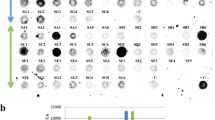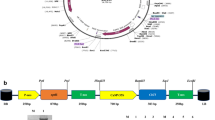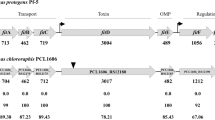Abstract
A 3′-end truncated crystal protein gene, derived fromBacillus thuringiensis (Bt) subsp.aizawai 7.21, encoding the toxic fragment of the insecticidal proteincryIA(b), was constructed. The gene was inserted into a transformation vector, also carrying the neomycin phosphotransferase II (nptII) gene and the β-glucuronidase (gus) gene, and introduced in the oncogenicAgrobacterium tumerfaciens strain A281, harbouring the Ti-plasmid pTiBO542. The recombinantAgrobacterium strain was used to transform leaf explants of chrysanthemum (Dendranthema grandiflora) cultivar Parliament. The resulting tumours were kanamycin-resistant, exhibited β-glucuronidase activity and produced agropine and mannopine. In most tumours, all simultaneously transferred genes were expressed, owing to selection for the presence of both T-DNAs, but no correlation was found between the level of expression of the various genes. A bioassay was developed, in which larvae were fed with tumorous chrysanthemum tissue, in order to detect the effect of the transferred toxin gene on larval development. Using this bioassay with second instar larvae ofHeliothis virescens (tobacco budworm), 17 tumour lines were tested. Several of these lines proved to be strongly inhibitory to larval growth. These results indicate thatBt-based insect resistance might be used as a tool in reducing the amount of pesticides used in chrysanthemum culture.
Similar content being viewed by others
References
Adang, M.J., Staver, M.J., Rocheleau, T.A., Leighton, J., Barker, R.F. and Thompson, D.V. (1985) Characterized full-length and truncated plasmid clones of the crystal protein ofBacillus thuringiensis subsp.kurstaki HD-73 and their toxicity toManduca sexta.Gene 36, 289–300.
Bradford, M.M. (1976) A rapid and sensitive method for the quantitation of microgram quantities of protein utilizing the principle of proten-dye binding.Anal. Biochem. 72, 248–54.
Brewer, G.J. (1991) Resistance toBacillus thuringiensis subsp.kurstaki in the sunflower moth (Lepidoptera: Pyralidae)Environm.Entomol. 20, 316–22.
Dons, J.J.M., Mollema, C., Stiekema, W.J. and Visser, L. (1991) Routes to the development of disease resistant ornamentals. In Harding, J., Mol, J., Sing, F. eds.,Genetics and Breeding of Ornamental Species, pp. 387–417. Dordrecht: Kluwer Academic Publishers.
Ferré, J., Real, M.D., Van Rie, J., Janssens, S. and Peferoen, M. (1991) Resistance to theBacillus thuringiensis bioinsecticide in a field population ofPlutella xylostella is due to a change in a midgut membrane receptor.Proc. Natl Acad. Sci. USA 88, 5119–23.
Fischhoff, D.A., Bowdish, K.S., Perlak, F.J., Marrone, P.G., McCormick, S.M., Niedermeyer, J.G., Dean, D.A., Kusano-Kretzmer, K., Mayer, E.J., Rochester, D.E., Rogers, S.G. and Fraley, R.T. (1987) Insect tolerant transgenic tomato plants.Bio/Technology 5, 807–13.
Gould, F. and Anderson, A. (1991) Effects ofBacillus thuringiensis HD-73 delta-endotoxin on growth, behavior and fitness of susceptible and toxin-adapted strains ofHeliothis virescens (Lepidoptera: Noctuidae).Environm.Entomol. 20, 30–8.
Gould, F., Martinez-Ramirez, A., Anderson, A., Ferré, J., Silva, F.J., and Moar, W.J. (1992) Broad spectrum resistance toBacillus thuringiensis toxins inHeliothis virescens.Proc. Natl Acad. Sci. USA 89, 7986–90.
Harpster, M.H., Townsend, J.A., Jones, J.D.G., Bedbrook, J. and Dunsmuir, P. (1988) Relative strengths of the 35S cauliflower mosaic virus, 1′, 2′ and nopaline synthase promoters in transformed tobacco, sugarbeet and oilseed rape callus tissue.Mol. Gen. Genet. 212, 182–90.
Hill, D.S. (1987)Agricultural Insect Pests of Temperate Regions and Their Control, Cambridge, UK: Cambridge University Press.
Höfte, H., Buyssens, S., Vaeck, M. and Leemans, J. (1988) Fusion proteins with both insecticidal and neomycin phosphotransferase II activity.FEBS Let. 226, 364–370.
Höfte, H. and Whitely, H.R. (1989) Insecticidal crystal proteins ofBacillus thuringiensis.Microbiol. Rev. 53, 242–255.
Honée, G., Vriezen, W. and Visser, B. (1990) A translation fusion product of two different insecticidal crystal protein genes ofBacillus thuringiensis exhibits an enlarged insecticidal spectrum.Appl. Environ. Microbiol. 56, 823–5.
Hood, E.E., Helmer, G.C., Fraley, R.T. and Chilton, M.D. (1986) The hypervirulence region ofAgrobacterium tumefaciences A281 is encoded in a region of pTiBO542 outside of T-DNA.J. Bacteriol 168, 1291–301.
Jefferson, R.A. (1987) Assaying chimeric genes in plants: thegus gene fusion system.Pl. Mol. Biol. Rep. 5, 387–405.
Jefferson, R.A., Kavanagh, T.A. and Bevan, M.W. (1987) GUS fusions: β-glucuronidase as a sensitive and versatile gene fusion marker in higher plants.EMBO J. 6, 3901–7.
Koncz, C., Mayerhofer, R., Koncz-Kahlman, Z., Nawrath, C., Reiss, B., Redei, G.P. and Schell, J. (1990) Isolation of a gene encoding a novel chloroplast protein by T-DNA tagging inArabidopsis thaliana.EMBO J. 9, 1337–46.
Langridge, W.H.R., Fitzgerald, K.J., Koncz, C., Schell, J. and Czalay, A.A. (1989) Dual promoter ofAgrobacterium tumerfaciens auxin synthesis genes is regulated by plant growth hormones.Proc. Natl Acad. Sci. USA 86, 3219–23.
McCown, B.H., McCabe, D.E., Russel, D.R., Robison, D.J., Barton, K.A., and Raffa, K.F. (1990) Stable transformation ofPopulus and incorporation of pest resistance by electric discharge particle acceleration.Pl. Cell Rep. 9, 590–4.
McDonnell, R.E., Clark, R.D., Smith, W.A. and Hinchee, M.A. (1987) A simplified method for the detection of neomycin phosphotransferase II activity in transformed plant tissues.Pl. Mol. Biol. Rep. 5, 380–86.
McGaughy, W.H. and Johnson, D.E. (1987) Toxicity of different serotypes and toxins ofBacillus thuringiensis to resistant and susceptible Indianmeal moths (Lepidoptera: Pyralidae).J. Econ. Entomol. 80, 1122–6.
McGaughy, W.H. and Beeman, R.W. (1988) Resistance toBacillus thuringiensis in colonies of Indianmeal moth and almond moth (Lepidoptera: Pyralidae).J. Econ. Entomol. 81, 28–33.
Mullis, K.B., Faloona, F.A., Scharf, S.J., Saiki, R.K., Horn, G.T. and Ehrlich, H.A. (1986) Specific enzymatic amplification of DNAin vitro: the polymerase chain reaction.Cold Spring Harbor Symp. Quant. Biol. 51, 263–73.
Murashige, T. and Skooge, F. (1962) A revised medium for rapid growth and bio assays with tobacco tissue cultures.Physiol. Plantarum 15, 473–97.
Perlak, F.J., Deaton, R.W., Armstrong, T.A., Fuchs, R.L., Sims, S.R., Greenplate, J.T. and Fischhoff, D.A. (1990) Insect resistant cotton plants.Bio/Technology 8, 939–43.
Perlak, F.J., Fuchs, R.L., Dean, D.A., McPherson, S.L. and Fischhoff, D.A. (1991) Modification of the coding sequence enhances plant expression of insect control protein genes.Proc. Natl Acad. Sci. USA 88, 3324–8.
Petit, A., David, C., Dahl, G.A., Ellis, J.G., Guyon, P., Casse-Delbart, F. and Tempé, J. (1983) Further extension of the opine concept; plasmids inAgrobacterium rhizogenes cooperate for opine degradation.Mol. Gen. Genet. 190, 204–14.
Platt, S.G. and Yang, N.S. (1987) Dot assay for neomycin phosphotransferase activity in crude cell extracts.Anal. Biochem. 162, 529–35.
Rogers, S.G., Klee, H., Horsch, R.B. and Fraley, R.T. (1988). Use of cointegrating Ti-plasmid vectors. In: Gelvin, S.R. and Schilperoort, R.A. eds.,Plant Molecular Biology Manual A2: 1–12. Dordrecht: Kluwer Academic Publishers.
Rossiter, M., Yendol, W.G. and Dubois, N.R. (1990) Resistance toBacillus thuringiensis in gypsy moth (Lepidoptera: Lymantriidae): genetic and environmental causes.J. Econ. Entomol. 83, 2211–8.
Saito, K., Yamazaki, M., Kaneko, H., Murakoshi, I., Fukuda, Y. and Van Montagu, M. (1991) Tissue-specific and stress enhancing expression of the TR promoter for mannopine synthase in transgenic medicinal plants.Planta 184, 40–6.
Sambrook, J., Fritsch, E.F. and Maniatis, T. (1989)Molecular Cloning: a Laboratory Manual. Cold Spring Harbor, New York: Cold Spring Harbor Laboratory Press.
Stone, T.B., Sims, S.R. and Marrone, P.G. (1989) Selection of tobacco budworm for resistance to a genetically engineeredPseudomonas fluorescens containing the σ-endotoxin ofBacillus thuringiensis subsp.kurstaki.J. Invert. Pathol. 53, 228–34.
Sutton, D.W., Havstad, P.K. and Kemp, J.D. (1992) SyntheticcryIIIA gene fromBacillus thuringiensis improved for high expression in plants.Transgen. Res. 1, 228–36.
Tabashnik, B.E., Finson, N. and Johnson, M.W. (1991) Managing resistance toBacillus thuringiensis: lessons from the diamondback moth (Lepidoptera: Plutellidae).J. Econ. Entomol. 84, 49–55.
Töpfer, R., Matzeit, V., Groneborn, B., Schell, J. and Steinbiss, H.H. (1987) A set of plant expression vectors for transcriptional and translational fusions.Nucl. Acids Res. 15, 5890.
Vaeck, M., Reynaerts, A., Höfte, H., Jansens, S., De Beuckeleer, M., Dean, C., Zabeau, M., Van Montagu, M. and Leemans, J. (1987) Transgenic plants protected from insect attack.Nature 328, 33–7.
Van Wordragen, M.F., De Jong, J., Huitema, J.B.M. and Dons, J.J.M. (1991) Genetic transformation of chrysanthenum using wild-typeAgrobacterium strains: strain and cultivar specificity.Pl. Cell Rep. 9, 505–8.
Van Wordragen, M.F., De Jong, J., Schornagel, M.J. and Dons, J.J.M. (1992) Rapid screening for host-bacterium interactions inAgrobacterium-mediated gene transfer to chrysanthemum, by using the GUS-intron gene.Pl. Sci. 81, 207–214.
Zambryski, P. (1988) Basic processes underlyingAgrobacterium-mediated DNA transfer to plant cells.Ann. Rev. Genet. 22, 1–30.
Author information
Authors and Affiliations
Rights and permissions
About this article
Cite this article
van Wordragen, M.F., Honée, G. & Dons, H.J.M. Insect-resistant chrysanthemum calluses by introduction of aBacillus thuringiensis crystal protein gene. Transgenic Research 2, 170–180 (1993). https://doi.org/10.1007/BF01972611
Received:
Revised:
Accepted:
Issue Date:
DOI: https://doi.org/10.1007/BF01972611




